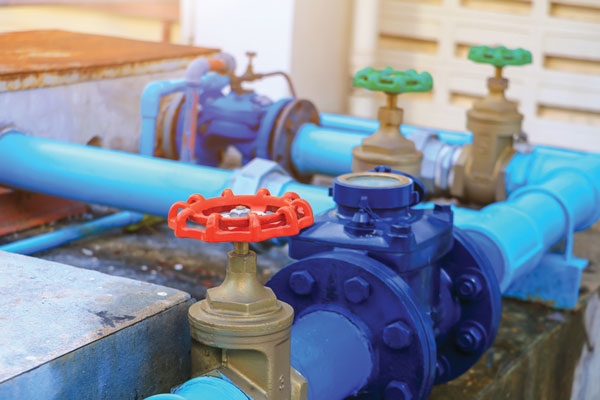COVID-19 Could Lead to Cleaner, Healthier Buildings

Expanded sanitation processes and improved HVAC systems could become standard in the years ahead.
The coronavirus pandemic is forcing building owners and tenants to consider something they may not have given much thought to in the past — how clean their facilities really are.
The good news is that most property managers were well prepared for the outbreak. A survey conducted in March by Appfolio found that 90% had already set up strategies for dealing with coronavirus, including revised sanitation policies.
“Within our company and all the properties, we established a communications system to track on a daily basis cleaning supplies and sanitation supplies at every property,” said Barry Blanton, senior vice president with Blanton Turner, during a recent NAIOP webinar. (Blanton Turner is based in Seattle, an early COVID-19 hot spot.)
Continuing those policies after the pandemic subsides could pay off, too. Larry Lander, a principal with Texas-based design firm PDR, recently told Loopnet that building owners who can demonstrate a commitment to things such as improved HVAC systems and regular deep cleaning could stand out as the market recovers from the pandemic.
Current Industry Observations
Gregory May, executive vice president and West Region market leader for Newmark Knight Frank, said he observed landlords sanitizing their buildings and prominently displaying social-distancing reminders and public health information before they were forced to close in the early days of the pandemic.
“We’ll see a lot more of that as we get back to work,” he said during a recent NAIOP webinar.
Susan Freeman, a partner in the real estate department of London-based law firm Mishcon de Reya, agrees that sanitation will be a prominent issue in the workplace in the months ahead as restrictions are lifted and people return to their jobs.
“There will be a lot more attention to cleanliness and the need to be a lot more careful about high-touch surfaces in buildings,” she said during a recent online panel discussion between real estate professionals in the U.S., the U.K. and France.
Pamela Westhoff, a partner in the real estate, land use and environmental practice group with the Sheppard Mullin law firm’s Los Angeles office, said she was working in a building where someone tested positive for COVID-19 before widespread closures began. The building owners put in measures to ensure a clean and safe work environment.
“There was hand sanitizer everywhere,” she said during a recent NAIOP webinar. “Everybody going near the elevator bank was freaked out about touching the elevator buttons, so they actually had facilities staff with gloves pushing them. Until we figure out immunity and get a vaccine, things like that are going to be essential as we return to the office.”
HVAC Systems
Indoor air quality could become a critical concern in the workplace in the aftermath of the COVID-19 pandemic.
“Fresh air was a major focus in the 1980s ‘sick building syndrome’ era,” Lander told Loopnet. “Building owners and developers will increasingly look to expand upon those efforts.”
Lander said air-filtration technologies used in health care facilities could start to show up in commercial buildings, a view that was echoed by Spencer Levy, chairman of Americas research and senior economic advisor for CBRE.
“What’s the best example I can give you? Medical office buildings,” he said during a recent webinar for NAIOP Maryland members. “They have a higher standard of care regarding things like better HVAC. You may see that type of thing become more standard in offices going forward.”
While the main source of the disease’s transmission is via droplets exhaled by people in close contact with one another, there is evidence that the virus can linger in the air and move through HVAC systems.
“If viruses that are viable are in those droplets that you’re producing, some of them will be small enough that they will stay airborne for a long time,” said William Bahnfleth, founding director of the Indoor Environment Center at Pennsylvania State University, in a recent interview with Air Conditioning, Heating and Refrigeration News. ”So, it’s not impossible that infectious particles in the air could stay aloft long enough to be collected, say at the return grille of an HVAC system, go through a duct, and infect someone in a different space.”
A study published in April by the U.S. Centers for Disease Control and Prevention showed that a single infected diner at a windowless 1,500-square-foot restaurant in Guangzhou, China, sickened nine other customers in January. Researchers said coronavirus-laden breath droplets were dispersed in the air by the building's HVAC system.
While viruses are microscopically tiny, some air-filtration systems can block them. According to an April article from Wirecutter, air purifiers with high-efficiency particulate air (HEPA) filtration can capture particles the size of the coronavirus.
Ultraviolet germicidal irradiation can also kill viruses and bacteria in HVAC systems. An ultraviolet light is either placed in proximity to the airstream to kill pathogens as they move into occupied space, or beamed onto the interior parts of HVAC systems (cooling coils, drain pans) to keep them free of contagions.
Adjusting the humidity of the indoor air is another strategy. A recent study from researchers at Yale shows that higher humidity can reduce the airborne mobility of the coronavirus.
“The cold, dry air of winter clearly helps SARS-CoV2 — the virus that causes COVID-19 — spread among people,” the Yale researchers said in a statement. “But as humidity increases during spring and summer, the risk of transmission of the virus through airborne particles decreases both outside and indoors in places such as offices.”
“Ninety percent of our lives in the developed world are spent indoors in close proximity to each other,” said Yale immunobiologist Akiko Iwasaki in the statement. “What has not been talked about is the relationship of temperature and humidity in the air indoors and outdoors and aerial transmission of the virus.”
According to the researchers, mice exposed to air with a relative humidity between 40% and 60% are substantially less likely to transmit viruses to non-infected mice.
“That’s why I recommend humidifiers during the winter in buildings,” Iwasaki said.
Finally, the CDC recommends a lowtech way to help keep the air clean — open the windows. An April report on COVID-19 from the Department of Homeland Security found that increasing air exchanges, either through the HVAC system or opening windows, could reduce the indoor aerosol risk of the virus.
Plumbing: A Possible Area of Concern
Reports from China indicate that the coronavirus is present in the feces of patients and has the potential to spread through a building if the waste piping is broken. This happened in Hong Kong during the 2003 SARS outbreak, when more than 300 infections and 42 deaths were linked to faulty plumbing in one Hong Kong high-rise apartment building. While there is no evidence at this time that anyone has been infected with COVID-19 through plumbing, in March the International Association of Plumbing and Mechanical Officials said in a technical guide for its members that “it should be assumed by anyone working on a sanitary drainage system that the virus is present.” The association urged plumbers to use proper personal protective equipment (PPE), including shields and gloves.

While plumbing is not considered a major coronavirus threat, plumbers are being urged to wear extensive personal protective equipment when making repairs. Getty Images
However, buildings closed for several weeks by the COVID-19 pandemic could face another health risk — Legionnaires’ disease. According to an April report from Reuters, low water use in shuttered buildings could create perfect conditions for the bacteria that causes the pneumonia-like infection to thrive because of a lack of chlorinated water flowing through pipes.
“It’s a worldwide problem, one that can be solved with precautions,” British microbiologist Susanne Surman-Lee told the news agency. “Most major corporations with consultants are likely to be aware of the stagnant water systems issue, but this is going to be a challenge for smaller retail-style shops, health clubs and hotels.”
According to Reuters, Canada’s Public Services and Procurement agency issued a warning about the risk on April 6, saying that pipes should be thoroughly flushed for at least 30 minutes in buildings that have been closed for at least a week.
Legionnaires’ disease first emerged during a 1976 American Legion convention in Philadelphia. The outbreak, which spread from the cooling tower of a hotel’s air conditioning system, sickened 182 people and killed 29. According to the CDC, about 50,000 people came down with Legionnaires’ disease between 2000 and 2015. Symptoms include cough and fever, which are similar to those caused by COVID-19.
Trey Barrineau is the managing editor of Development magazine. NAIOP Senior Communications Manager Brielle Scott contributed to this report.
Facility Cleaning After COVID-19 ExposureThe COVID-19 pandemic could remain a threat for up to a year or more. Because of that, it’s important for building owners to understand U.S. Centers for Disease Control and Prevention (CDC) cleaning procedures for facilities as they reopen. This information is from the CDC’s website: www.cdc.gov/coronavirus/2019-ncov/community/organizations/cleaning-disinfection.html If a Suspected/Confirmed COVID-19 Case Has Been in the Facility
Hard (Non-porous) Surfaces
Soft (Porous) Surfaces
Electronics
Linens, Clothing and Other Items That Go in the Laundry
|




